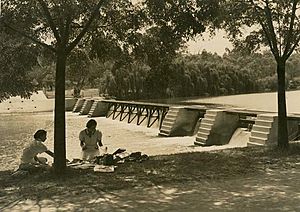Yanco Weir facts for kids
Quick facts for kids Yanco Weir |
|
|---|---|

Undated photograph of a picnic area at Yanco Weir
|
|
| Location | Yanco, Leeton Shire, New South Wales, Australia |
| Built | 1928–1929 |
| Owner | Department of Planning and Infrastructure |
| Official name: Yanco Weir and site | |
| Type | State heritage (built) |
| Designated | 2 April 1999 |
| Reference no. | 969 |
| Type | Weir |
| Category | Utilities – Water |
| Builders | WC & IC |
| Lua error in Module:Location_map at line 420: attempt to index field 'wikibase' (a nil value). | |
Yanco Weir is an old structure in Yanco, New South Wales, Australia. It was built between 1928 and 1929. A weir is like a small dam that helps control water flow. This weir is important because it's listed on the New South Wales State Heritage Register. This means it's a special historical site. The Department of Planning and Infrastructure owns it.
Contents
History of Yanco Weir
The Yanco Weir was built to help farmers. It was finished in 1929. Its main job was to take water from the Murrumbidgee River. This water then flowed into smaller creeks like Yanko, Colombo, and Billabong. This system helped irrigate, or water, many farms.
In 1980, the weir was made bigger. This allowed it to send even more water to the farms. This helped more farms grow in the area. Around 1980, a new weir was built nearby. The original 1929 weir was then covered with concrete. It is no longer used for water control today. However, you can still see parts of the old structure.
What Yanco Weir Looks Like
The 1929 Yanco Weir is about 14 kilometers downstream from Narrandera. It is about 75.59 meters wide. The weir has a concrete base. On top of this base are several concrete pillars. These pillars are about 3.58 meters tall.
The concrete base was originally strengthened with wood. In 1980, it was made even stronger with more concrete. Since the new weir was built, the old one has been covered in concrete. The area around the old weir still shows signs of its past. You can see old poles that were used to open and close the weir gates. There are also scales that show how high the floodwaters used to be.
Changes Over Time
The original weir was covered with concrete around 1980. It is not used anymore for its original purpose.
Why Yanco Weir is Important
The 1929 Yanco Weir is one of the first weirs built on the Murrumbidgee River. It helped control water for the Murrumbidgee Irrigation Area. This area became very important for farming. The weir shows how the irrigation system changed over time. The site also has many parts of the original structure.
Yanco Weir was added to the New South Wales State Heritage Register in 1999. This means it is recognized for its historical value.
Its Place in History
The old Yanco Weir is a very important structure. It was built during the early days of the Murrumbidgee Irrigation Area. It was a key part of the Murray Irrigation Scheme. This scheme helped develop farming in the region.
Beauty and Design
The area around the weir is also very pretty. It has been made nice for visitors and for fun activities. Native and other trees grow along the riverbanks. Many birds live in the water and trees. The weir, trees, and birds make the area a beautiful place to visit.
Community Connection
The old Yanco Weir was very important for farming in the area. It helped early settlers and soldiers who returned from World War I and II. They used the water for their farms. The area has also been a popular place for people to relax and have fun. It is a well-known landmark in the community.
A Great Example
Even with some changes made in the 1970s, the weir is a good example of how weirs were built. It shows how irrigation systems were created in the early days of the Murrumbidgee Irrigation Scheme.

